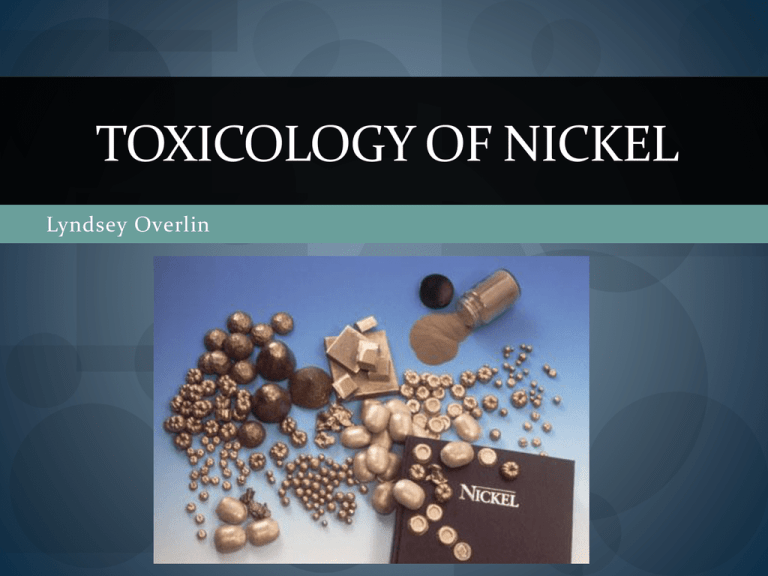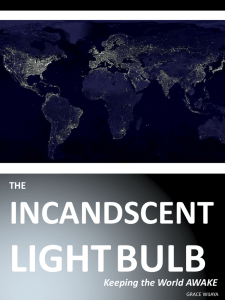Document
advertisement

TOXICOLOGY OF NICKEL Lyndsey Overlin Basic Chemical Properties of Nickel This metal doesn’t oxidize very quickly There are a few common oxidation states +2 Ni, +1 Ni, and +3 Ni The most common:+2 Ni Basic Physical Properties of Nickel It conducts heat and electricity fairly well It’s magnetic There are 14 known isotopes, 5 naturally occurring of Nickel Ni 58 (68.27%) Ni 60 (26.10%) Ni 61 (1.1%) Ni 62(3.6%) Ni 64 (0.9%) Chemical Properties (cont.) There are also 6 major radioactive isotopes of which Ni 59 and Ni 63 have the most prevalent half-life Ni 59: 75 000 years (captures electrons) Ni 63: 96 years (emits beta particle) Origin and History of Nickel Use Nickel was used as an alloying metal almost 2000 years before is it officially discovered 200 B.C.E the Chinese used Copper ore for manufacturing It was from this copper ore that Nickel was eventually isolated Discovered in 1751 by Axel Fredrik Cronstedt By 1844 the demand for Nickel had significantly increased It is thought that Nickel came from an ancient meteor impact creating Ore Estimated Crustal Abundance: 8.4×101 milligrams per kilogram Estimated Oceanic Abundance: 5.6×10-4 milligrams per liter Uses and Applications Nickel is manufactured for use in products such as: Alloys Steel Manufacturing Electroplating Batteries Electronics Other chemical uses How does it get into the Aquatic Environment? Sediment Insoluble forms with silicates and sulfides as well as soluble forms (run-off ) Atmosphere Mainly from the burning of fossil fuels which emits oxides, sulfides, silicates, as well as many soluble forms (particulates in rain water) Water Leaching from rocks Once Nickel is in the Aquatic Environment… Deep water concentrations range from 0.1 to 0.5 ppb Ni, whereas surface water contains 15–20 ppb Divalent Nickel is the most common form within this environment How Ni toxicity and water chemistry interact is not well understood. Enhances microbial growth at LOW concentrations It typically occurs as soluble salts absorbed in sediments, organic matter, or by biota Van Baalen and O’Donnell, 1978 Toxicity to Aquatic Life? Some suggest it is essential in some concentrations Higher concentrations result in variable effects on marine life Life expectancy is significantly altered for Daphnia at 40 ppb LD50 for marine lobsters is between 150-300 ppm Variable in fish species Toxic Effects Humans: Lung and nasal cancers when inhaled Nickel dermatitis Carcinogenic Animals: Lung tumors Impaired immune systems Decreased number of live pups, increased pup mortality Sperm abnormalities STUDIES OF EFFECTS ON AQUATIC BIOTA ARE LIMITED TO PHYTOPLANKTON AND CYANOBACTERIA!! Mode of Entry The majority of cyanobacteria and phytoplankton studied within the aquatic environments require Nickel for: Urease ((NH2)2CO +2H20 →H2CO3 + 2NH3) Hydrogenase ((2H+ 2e- H+ + H- H2) However, comparison of BCF’s (bioconcentration factor) and BSAF’s (biosediment accumulation factors) in various aquatic organisms shows a different story Also, the higher the solubility of Nickel, the higher the nickel uptake of various organisms Based on this it is more likely that Nickel is taken up through pore water within sediments instead of ingestion Nickel that is onsiluble enter cells through phagocytosis and enter into the cell in vacuoles. These vacuoles are acidified which causes the nickel to become soluble. Once in the nucleus, heterochromatin areas in the long arm of the X chromosome is damaged as Ni 2+ replaces Mg 2+. Molecular Mode of Toxic Interaction It has been shown that a low levels, Nickel is actually a requirement for many organisms However, once a threshold is reached, Ni can cause variable damage in organisms In plants: Increase levels of Nickel can result in decreasing chlorophyll contents and leaf photosynthetic activities through impairing permeability of membranes to other essential elements such as Iron. In other organisms: Suppression of the uptake of Zn, Cu, Fe, Mn, Ca, Mg, and S As these are suppressed by Nickel, parts of DNA can be silenced (not mutated) leading to cancer Biochemical Metabolism and Breakdown In order to better understand these processes, much research has been done on tissue accumulation of Nickel on various organisms Crayfish tend to have higher concentrations in the gills and the digestive gut when exposed to high levels of Nickel. It was discovered that they go through a 2 week active uptake process and then a 2 week active excretion process (which isn’t correlated with the organs) When looking at Catfish, concentrations of Nickel were as follows: kidney>liver>gill>intestine. From this it was inferred that fish are actively breaking down nickel through chloride cells in the kidney Sediments 5X blank 1A 1B 1C 2 3 Ni 2333 28592 37262 34858 34739 16901 Rh 530789 547591 516052 531160 590330 548859 Internal Standard Correction 2686 31901 44115 40096 35953 18813 4 5 6 7 8 47760 86965 43011 40653 37027 542499 510420 524010 545112 551353 53788 104097 50149 45565 41031 15.87066663990 30.78916366557 14.79129708028 13.43208193486 12.08755090761 468952 138.98426199890 Concentration 16.00494434 0.400588745 0.685692165 1.372948467 0.545107968 2.93543875 0.888736356 1.208402351 CRM 5x Ni 396677.4 516807.6 Concentration 0.71651374180 9.38024335397 13.00222645608 11.81025521444 10.58184573468 5.49899272880 Blank Correction Ratio Dilution 8.66372961217 12.28571271428 11.09374147264 9.86533199288 4.78247898700 0.47555 0.554367 0.430928 0.513765 0.443503 4.554587 5.540421 6.435965 4.800512 2.695854 15.15415289810 30.07264992377 14.07478333848 12.71556819306 11.37103716581 0.341452 0.40096 0.50839 0.467183 0.604947 11.09537 18.75042 6.921253 6.804379 4.699189 Blank Correction Ratio 0.069482 Dilution 115.1736 0.053638 0.052547 0.051819 0.057541 0.06097 0.062778 6.391807 13.06404 5.259712 25.50721 7.288281 9.62435 Tissues 10X 1 2 Ni 49936 1552 Rh 562479 585311 Internal Standard Curve Correction 54241.1833 1620.175367 4 5 6 7 7 8 2525 4707 2024 9701 3030 4178 597484 587049 586822 582876 566838 587588 2581.601117 4899.166822 2107.52309 10168.19655 3266.306739 4344.284408 Colorado Lagoon Our values we obtained for Nickel in the Colorado Lagoon were nowhere near the thresholds that have been set forth by the EPA 2. Hydrology and Water Quality reports on the Lagoon do not define Nickel to be one of the primary metals for concern ERL ERM BPTCP CL-West CL-East CL-1 CL-2 Cl-3 Nickel 21 51.6 34 36 32 18 14 8.9 1. mg/kg (dry) Concentrations that are underlined indicate ERM exceedences References Argonne National Laboratory. (2005). “Nickel: Human Health Fact Sheet”. Environmental Science Division. 1-2 Alikhan, M.A., Bagatto, G., and Zia, S. 1990. The crayfish as a “biological indicator” of aquatic contamination by heavy metals. Water Res. 24: 1069–1076. Azeez, P.A., and Banerjee, D.K. 1991. Nickel uptake and toxicity in cyanobacteria. Toxicol. Environmental Chemistry 30: 43–50. Costa, Max; Davidson, Todd L.; Chen, Haobin; Ke, Quingdong; Zhang, Ping; Yan, Yan; Huang, Chuanshu; and Kluz, Thomas. (2005). “Nickel carcinogenesis: Epigenetics and hypoxia signaling”. Mutation Research/Fundamental and Molecular Mechanisms of Mutagenesis. 592(1-2) 79-88. Denkhaus, E. and Salnikow, K. (2002). “Nickel essentiality, toxicity, and carcinogenicity”. Critical Reviews in Oncology/Hematology. V42:35-56 Eco-SSL. (2007). “Ecological Soil Screening Levels for Nickel”. U.S. Environmental Protection Agency. OSWER Directive 92857.7-76. 1-133. Eskew, D.L., Welch, R.M., and Cary, E.E. 1983. Nickel, an essential element for legumes and possibly all higher plants. Science (Washington), 222: 621–623. Gikas, Petros. (2008). “Single and combined effects of nickel (Ni(II)) and cobalt (Co(II)) on activated sludge and on other aerobic microorganisms”. Journal of Hazardous Materials. 159:187-203. References (continued) Kozlova, Tatianna; Wood, Chris M.; and McGeer, James C. (2009). “The effect of water chemistry on the acute toxicity of nickel to the cladoceran Daphnia pulex and the development of a biotic ligand model”. Aquatic Toxicology. 91:221-228. Munzinger, Armin. (1990). “Effect of nickel on daphnia magna during chronic exposure and alterations in the toxicity to generations pre-exposed to nickel”. Water Research. 24: 845-852. Muyssen, B.T.A; Brix, K.V.; DeForest, D.K.; and Janssen, C.R. (2004). “Nickel essentiality and homeostasis in aquatic organisms”. Environmental Reviews. 12:113-131. Oller, Adriana R. (2002). “Respiratory Carcinogenicity Assessment of Soluble Nickel Compounds”. Environmental Heal Perspectives Supplements. 110 (5). U.S. Environmental Protection Agency. (1999). Integrated Risk Information System (IRIS) on Nickel, Soluble Salts. National Center for Environmental Assessment, Office of Research and Development, Washington, DC. Van Baalen, C. and O’Donnell, R. (1978). “Isolation of a nickel dependent blue-green alga”. Journal of General Microbiology. 105:351-353 Yang, X.; Baligar, V.C.; Martens, D.C., and Clark, R.B. (1996). “Plant Tolerance to Nickel Toxicity: II Nickel Effect on Influx and Transport of Mineral Nutrients in Four Plant Species”. Journal of Plant Nutrition. 19:265-279.





